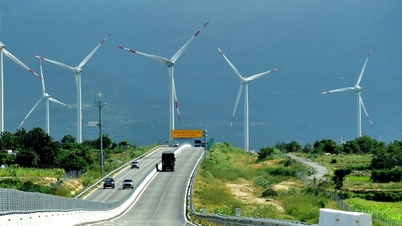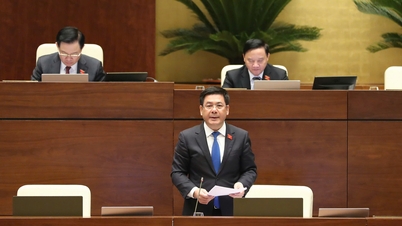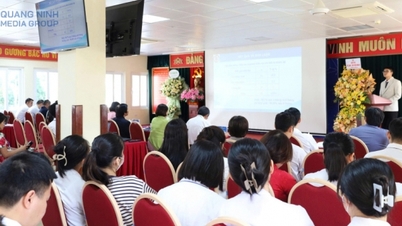The National Electricity System and Market Operator (NSMO) has just given an explanation about the recent status of the power system's operations on its official fanpage on Facebook.
As of November 13, on the official website of NSMO at https://www.nsmo.vn there is no information related to this matter.
NSMO's information was released when recently many wind power plants complained about large cuts in mobilized capacity during good wind conditions, causing economic losses to businesses.
Many storms bring a lot of water for hydroelectric power.
According to NSMO, in the recent past (especially October and early November 2025), the operation of the national power system has faced many challenges, mainly due to unfavorable weather factors and hydrological conditions of hydroelectric reservoirs.
A special point in the operation in 2025 is the irregular fluctuations of the weather. According to the inter-reservoir operation process and annual hydrological laws, at present, most hydroelectric reservoirs in the North, South and some reservoirs in the Central region have entered the water storage phase.

Song Tranh 2 Hydropower Plant operates safely, contributing to flood regulation and protection of downstream areas during heavy rains in October 2025.
In particular, hydroelectric reservoirs in the Red River basin in the North have switched to dry season operation phase since September 16.
However, in 2025, many major storms appeared one after another in the period of October-November 2025 such as RAGASA, BUALOI, MATMO, FENGSHEN, KALMAEGI, causing the number of reservoirs to continue to maintain a high level of discharge. Even in early November 2025, the number of reservoirs to discharge increased to 82-91/122 reservoirs, with the total capacity of hydroelectric reservoirs to discharge increasing to 15,940-17,040 MW (out of a total of 19,600 MW of hydroelectricity in the entire system).
It is worth mentioning that large lakes in the Northern region have had to reopen their discharge gates, such as Son La, Hoa Binh , and Lai Chau (the total capacity of the hydroelectric reservoirs in the Da River range is about 5,760 MW).
Forced to maintain coal-fired thermal power and BOT contracts with output guarantee requirements
Besides the favorable hydrology due to storms and rains causing hydropower to increase, the reality of low electricity consumption is mentioned by NSMO.
Specifically, although the demand for electricity consumption continues to remain low (due to the impact of storms and weather), the shape of the load chart shows sharp peaks according to seasonal characteristics and increases rapidly between 5:45 p.m. and 6:00 p.m. every day. The difference between the Northern load at low night and peak evening can reach 10,000-11,500 MW, and at the same time, during peak hours, it can increase/decrease 2,500-2,800 MW within 30-40 minutes.

The Van Phong 1 BOT Thermal Power Plant of Sumitomo Group (Japan) with a total investment of nearly 2.58 billion USD, went into operation in March 2024, after about 18 years of pursuit.
To ensure sufficient capacity to cover the 18-hour peak load as analyzed above, it is necessary to maintain the mobilization of coal-fired thermal power plants (which have a long start-up time and cannot be continuously and flexibly stopped/started like hydropower plants) only to increase capacity mobilization at peak times, while most of the remaining hours of the day are only mobilized at the minimum capacity level according to the technical requirements of the plant to ensure plant safety.
In addition, coal-fired thermal power plants need to be maintained to ensure the inertia of the power system (in this regard, renewable energy sources are almost unable to meet), ensure regional voltage regime and prevent overloading of power transmission lines.
In addition, BOT power plants must mobilize to ensure physical offtake commitments under the BOT Contract with Government guarantees with a total capacity of up to more than 4,000 MW, which is also a component accounting for a large proportion in the power mobilization structure.
With this situation, even though the wind power capacity increases when the storm affects the mainland, causing the potential capacity (able to generate electricity) to increase to about 3,400 - 4,000 MW, which is about 3 - 4 times higher than before, wind power cannot be mobilized as expected by investors.
Safety, stability and reliability come first
As the national power system dispatching unit, NSMO said it always puts the goal of operating the power system safely, stably, and reliably first.
From the beginning of October 2025, implementing the direction of the Prime Minister and the Ministry of Industry and Trade in the Official Dispatches on proactively responding to storm No. 11 (MATMO), storm No. 12 (FENGSHEN) and storm No. 13 (KALMAEGI), focusing on safely operating reservoirs, reasonably mobilizing power sources in the national power system, ensuring adequate power supply and reserves, promptly responding to unusual situations due to the impact of storms and coordinating with power generation units and grid management units to optimize the operating mode of power plants and grids.
Specifically, NSMO has implemented many operational measures such as stopping nearly 3,000 MW of coal-fired thermal power plants in the North as a backup right after storm No. 13 dissipated (these units need to be maintained to ensure system safety before and when the storm makes landfall).

Phu My 3 Power Plant uses LNG to generate electricity.
The daily shutdown/start-up of many domestic gas turbine units and LNG to meet peak power or maximize transmission capacity on interconnecting lines to relieve power source capacity.
However, NSMO also said that such continuous stopping/starting of gas turbine units will affect the durability and readiness of the unit. With the above technical constraints, maintaining this operating method for a long time is not feasible, because it not only reduces the life of the equipment but also potentially causes problems, affecting the safety and stability of the entire power system.
According to NSMO, despite implementing many operational measures, the system is still in a state of excess power during both the night and midday off-peak periods.
NSMO has been forced to make adjustments to mobilize power plants, reducing evenly between renewable energy sources and hydropower sources that are discharging when there is a large amount of excess capacity.
“Reducing capacity mobilization is a mandatory technical solution to ensure the power system operates safely, stably, continuously and maintains frequency and voltage within allowable limits as well as ensuring safety for the units being mobilized on the system. The dispatching and mobilization reduction orders are carried out based on technical calculations, ensuring the principles of fairness, transparency and non-discrimination between units, ” the NSMO announcement said.
In addition, NSMO also assessed that this surplus situation occurred due to the influence of many overlapping factors, including consecutive major storms with extreme weather patterns, which have a cumulative nature over a period of time and will not last long (depending on the storm and flood situation in the remaining time of 2025).
The situation is expected to improve soon when the storm circulation ends and hydrological conditions return to normal, other power sources will be mobilized to ensure safe operation of the system and store and retain water in hydroelectric reservoirs, preparing for the dry season of 2026.
Stimulus is the key
At the meeting of the Ministry of Industry and Trade on the 2026 Power System and Electricity Market Plan held on November 10, the forecast of electricity consumption load for 2025 was updated by NSMO, giving an expected figure of total electricity consumption of the entire national power system in 2025 to reach 322.6 billion kWh. That is, only 4.5% growth compared to 2024.
This figure is also far from the forecasts made at the end of 2024 that electricity demand in 2025 will grow at a high rate of 12% to meet the expected GDP growth of about 8%.

Coal-fired power still accounts for a large proportion of the electricity supply, from 40-50% depending on the time.
According to Decision No. 3047/QD-BCT dated November 15, 2024 on approving the Plan for electricity supply and operation of the national power system in 2025, the national power system will be operated with a planned growth rate of electricity production and import of 11.3% with a hydrological forecast of poor, the probability of incidents calculated at 10%...
Actual electricity consumption over the past 10 months also shows that the growth in electricity consumption nationwide is only around 4%.
Of course, when demand is not high, the power supply cannot be generated as expected by power plants. Especially when electricity is a special commodity whose production and consumption take place simultaneously, and if there are no electricity users, no one will buy electricity so that the plants can be mobilized to generate electricity.
Although the use of battery storage (BESS) is considered an optimal solution to store electricity when the power source is in excess for a long time, in reality, the investment capital for battery storage is not cheap, while the current price of buying electricity from BESS has not been issued by the Ministry of Industry and Trade. Even if the price of electricity from BESS is issued and the selling price to the system is higher than the average retail price of electricity in the economy, it will not be easy to sell, because of the fear of causing further losses for the only wholesale buyer at present, Vietnam Electricity Group (EVN).
Therefore, the urgent issue now is to stimulate electricity consumption in the economy to contribute to achieving the GDP growth target of over 8% in 2025 and higher at double digits in the following years.
Wind power complaints
According to complaints from wind power enterprises in Quang Tri, in the past 18 days (from October 19 to November 5), the national power system recorded a significant difference in dispatching between power sources.
According to statistics from the website of the National Electricity System and Market Operation Company Limited (NSMO), the electricity output from thermal power plants (coal, gas, oil) reached 6,598.9 GWh, accounting for 43.33% of the total output of the entire system. With an installed capacity of 39,746 MW, the average mobilized capacity ratio reached 38.43%.
In contrast, wind power only generated 582.9 GWh, equivalent to 3.83% of total output. Although the total installed capacity reached 7,102 MW, the average mobilized capacity of wind power was only 19%, less than half of that of thermal power, in the context that wind is in the most stable season of the year.
Faced with this situation, wind power enterprises in Quang Tri have sent a petition to the Ministry of Industry and Trade, Quang Tri Provincial People's Committee, EVN and NSMO, requesting consideration of limiting the reduction of available power generation capacity.
Specifically, from the end of September 2025 until now, the wind power plant cluster in Quang Tri has continuously had its capacity cut, at times up to 99%. On average, the capacity is reduced from 20% to 90%, causing October revenue to drop about 5% compared to the yearly plan.
If this situation persists until the end of the year, 2025 revenue could fall by 10-20%, while the target profit would be only 5-10% after deducting operating costs, debt repayment and maintenance. For average-performing projects, the actual profit would be less than 5%.
“ With the current cutbacks, the lost revenue is greater than the expected profit. If this continues, the company will not be able to repay bank loans, maintain operations and employee welfare. The risk of bankruptcy is entirely possible ,” a representative of a wind power company worried.
Source: https://vtcnews.vn/ly-do-dien-gio-bi-cat-giam-cong-suat-khien-doanh-nghiep-lo-lang-ar986922.html


![[Photo] Unique art of painting Tuong masks](https://vphoto.vietnam.vn/thumb/1200x675/vietnam/resource/IMAGE/2025/11/14/1763094089301_ndo_br_1-jpg.webp)

![[Photo] Unique architecture of the deepest metro station in France](https://vphoto.vietnam.vn/thumb/1200x675/vietnam/resource/IMAGE/2025/11/14/1763107592365_ga-sau-nhat-nuoc-phap-duy-1-6403-jpg.webp)
































![[Photo] Special class in Tra Linh](https://vphoto.vietnam.vn/thumb/1200x675/vietnam/resource/IMAGE/2025/11/14/1763078485441_ndo_br_lop-hoc-7-jpg.webp)








































































Comment (0)